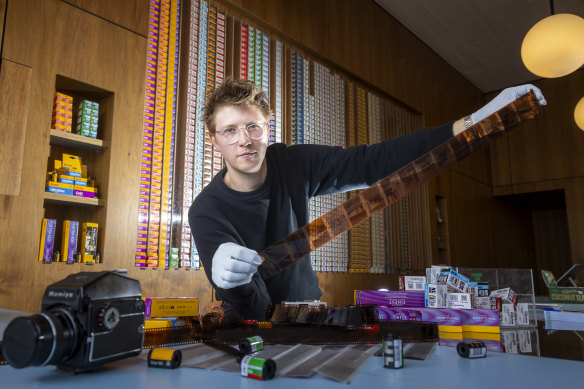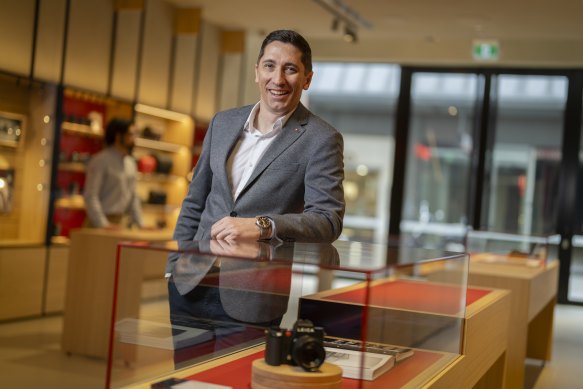By Cara Waters
The result might be blurry, the subject’s eyes might be closed and the flash is likely to be unforgiving – you will also need to have the picture developed. Despite all that, film photography is back.
The demand is strong enough that some stores, including Walkens House of Film in Fitzroy and Film Never Dies in the CBD, have opened to exclusively sell and process film, while the hashtag #filmphotography has been used 42.3 million times on Instagram.

Tyler Brady-Brown, is the owner of Walkens House of Film, and said there has been a resurgence in film photography. Credit: Wayne Taylor
“You have to slow down and be more deliberative about what you are going to take a photo of, and it’s a less instant result,” Tyler Brady-Brown, owner of Walkens House of Film, says. “It’s very different to taking a photo on your phone.”
Brady-Brown says film’s revival has been driven by younger consumers who may not have experienced film photography before and don’t always want the printed photograph.
“Now it is a hybrid, where you shoot on film, you process it, then it gets scanned and most people just take the digital photos, so they might share a select few online,” he says.
In a world where everything is documented, instantaneous and overshared, Brady-Brown says there is privacy and exclusivity to film photography.
“People might have a wild night and then drop it back a week later, so it is this kind of delayed review of what happened,” he says. “They have forgotten half the photos they have taken.”
Analogue devices are a novelty for those who have grown up in an overwhelmingly digital era.
Model and “It girl” Kendall Jenner took her old school film camera to the Met Gala, while Shameless Media’s Zara McDonald likes to post her “Holidayz on film” photographs to Instagram.
It’s quite the comeback for film photography, which reached its peak in 2003 when almost a billion rolls of film were sold, and was then gutted by digital cameras and mobile phones, leading one-time industry giant Kodak to file for bankruptcy in 2012.

Ryan Williams is the managing director of Leica, which has opened a flagship store in Melbourne offering film photography workshops. Credit: Eamon Gallagher
Like vinyl records, sales may be a fraction of what they were, but film has experienced something of a revival.
“Kodak in New York are at full production, and they basically can’t meet demand,” Brady-Brown says. “They are probably ruing the fact they demolished a bunch of factories.”
Last month, German camera brand Leica opened a flagship store in Melbourne offering film photography workshops and a drop-off service for film processing.
Managing director Ryan Williams says that in 2012, Leica’s production dropped to only 500 film cameras a year globally, but 12 years later the company sells that number of film cameras in Australia alone.
He says many people got into photography during the pandemic and discovered film photography.
“The act of taking a photo with a film camera is more considered,” he says. “You’ve really got to think, ‘I’m literally spending money every time I click the button.’”
Williams says the increased popularity of film shows a shift from the “instant gratification” of digital photography.
“Photographers, have certainly seen and found that film cameras have a place, as much as vinyl has a place in the music, in the hi-fi space as well, for the real purists,” he says. “You can’t really fake a film photograph – it’s as raw and as real as it can get.”
The Morning Edition newsletter is our guide to the day’s most important and interesting stories, analysis and insights. Sign up here.